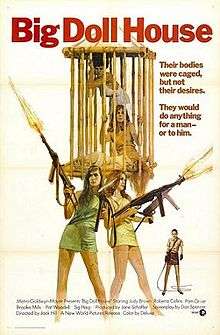The Big Doll House
| The Big Doll House | |
|---|---|
 Theatrical release poster | |
| Directed by | Jack Hill |
| Produced by | Jane Schaffer |
| Written by | Don Spencer |
| Starring |
Judy Brown Roberta Collins Pam Grier Sid Haig Christiane Schmidtmer |
| Music by | Hall Daniels |
| Cinematography | Fred Conde |
| Edited by | Cliff Fenneman |
| Distributed by |
Metro-Goldwyn-Mayer New World Pictures |
Release dates |
|
Running time | 95 minutes |
| Country |
United States Philippines |
| Budget | $125,000[1] |
| Box office | $10 million[2] |
The Big Doll House is a 1971 American women in prison film starring Pam Grier, Judy Brown, Roberta Collins, Brooke Mills, and Pat Woodell. The film follows six female inmates throughout daily life in a gritty, unidentified supra-tropical prison. Later the same year the film Women in Cages featured a similar story and setting, much the same cast, and was shot in the same abandoned prison buildings. A non-sequel follow-up, titled The Big Bird Cage, was released in 1972.[3]
Plot
Collier (Brown) enters prison, having been found guilty of killing her husband. She is introduced to the beautiful occupants of her cell, in for crimes ranging from political insurgency to heroin addiction. The women often clash, which leads to their torture by sadistic guard Lucian (Kathryn Loder). The torture ceremonies are viewed by an impassive cloaked figure.
Collier's cellmates Alcott and Bodine (Collins and Woodell) plan to escape. Collier and another cellmate Ferina (Gina Stuart) agree to go along. Assisting is their other lesbian cellmate Grear (Pam Grier), though there are doubts Grear's heroin addict girlfriend Harrad (Brooke Mills) will be equipped to escape.
Ferina, Alcott and Bodine break from the solitary confinement sauna and take their revenge on Lucian. The escapees wield guns, attitude, and sexuality to free themselves.
During their escape they round up various personnel from the prison as hostages, taking elegant prison warden Miss Dietrich (Christiane Schmidtmer), sympathetic prison medic Dr Phillips (Jack Davis), and two local men regularly allowed access to the prison to sell market produce, Harry (Sid Haig) and Fred (Jerry Franks).
Cast
- Pam Grier as Grear
- Judy Brown as Collier
- Roberta Collins as Alcott
- Sid Haig as Harry
- Brooke Mills as Harrad
- Pat Woodell as Bodine
- Christiane Schmidtmer as Miss Dietrich
- Kathryn Loder as Lucian
Production
This was one of the first films made by B movie giant Roger Corman for his company New World Pictures. According to Stephanie Rothman, Corman originally purchased a screenplay by James Gordon White, which he then asked to be rewritten. Rothman says she, her husband Charles S. Swartz and New World story editor Frances Doel pitched story proposals to Jack Hill, who did not like any of them. They then plotted a new storyline themselves and hired Don Spencer to write the screenplay. Rothman also says that Corman wanted her to direct the picture but she turned it down so Corman hired Jack Hill instead.[4]
John Ashley says Corman originally intended to make the film in Puerto Rico but he persuaded them to make it in the Philippines. Ashley and his partners went on to put up the above the line part of the budget, with Corman providing the rest.[5]
The tag line "Their bodies were caged, but not their desires. They would do anything for a man. Or to him." encapsulates the rather contradictory air expressed by the inmates as they yearn for freedom of multiple kinds; sexual, political, and perhaps ideological — while simultaneously acting as agent provocateur. As a drive in film of the first order, it retains an energetic over an intellectual bent, and thus avoids serious consideration of or accuracy in portraying the actual situation of female American prisoners, instead fulfilling the genre characteristics of Hollywood's women in prison films. Director Jack Hill later made Coffy, a blaxploitation film with Grier which is based on personal vendetta.
Reception
The film earned $3 million in rentals.[6]
See also
References
- ↑ Gary Morris, 'Roger Corman's New World Pictures: Notes toward a Lexicon' Bright Lights Film Journal, January 2000
- ↑ "The Big Doll House, Box Office Information". The Numbers. Retrieved June 24, 2012.
- ↑ The Big Doll House at the Internet Movie Database
- ↑ 'Stephanie Rothman Sets Record Straight', Temple of Schlock July 31, 2010
- ↑ Tom Weaver, "Interview with John Ashley", Interviews with B Science Fiction and Horror Movie Makers: Writers, Producers, Directors, Actors, Moguls and Makeup, McFarland 1988 p 43
- ↑ Roger Corman & Jim Jerome, How I Made a Hundred Movies in Hollywood and Never Lost a Dime, Muller, 1990 p 183
External links
- The Big Doll House at the Internet Movie Database
- The Big Doll House at Rotten Tomatoes
- Jack Hill on The Big Doll House at Trailers From Hell